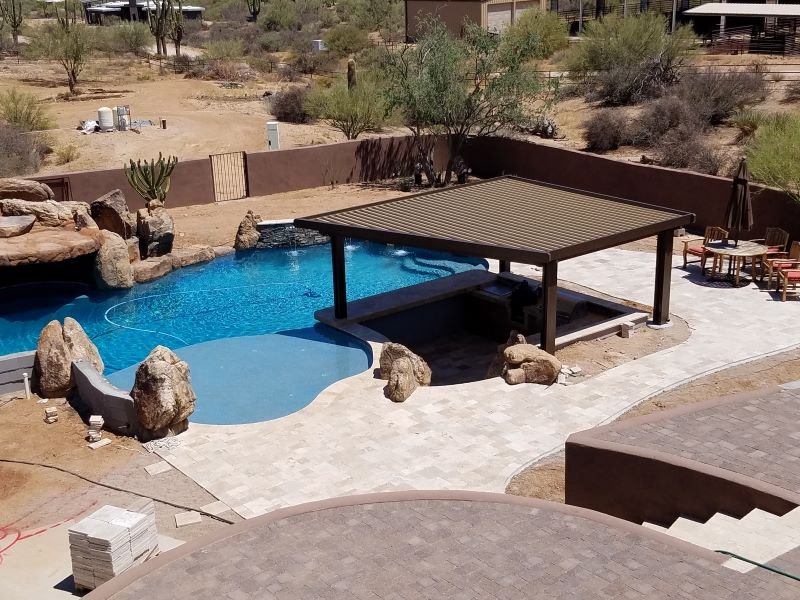The perfect pergola is a personalized pergola – one that is designed to meet your specific needs and expectations. When constructing a pergola, the characteristics you find important may not align with what your neighbor finds ideal.
Do you want to host large outdoor gatherings under the cool shade of an attached pergola, or would you rather have a freestanding pergola covered in lush greenery standing as an artistic centerpiece to your flower garden?
Outdoor structures come in all shapes and sizes, so determining the perfect pergola often comes down to individualized preferences.
Planning Out Your Pergola
Simply knowing that you want a pergola is the easy part of the pergola-building process. The steps that follow are the tricky portion of the process. You must determine the size, location, material type, and layout of your pergola.
Proper planning is essential if you want the end result to match your vision, so what should you consider before you break ground? Follow these three steps to ensure you create the pergola of your dreams.
#1 – Identify the Purpose
First, you need to identify what you hope to accomplish by putting in a pergola. Do you want your pergola to serve as a small, intimate space with just a bench, or does it need to be large enough to accommodate a big group of guests and multiple pieces of furniture? Do you want a poolside pergola in order to shade lounge chairs, a pergola that covers an outdoor kitchen, or a pergola for aesthetic purposes to beautify your yard?
If you do not know why you want a pergola, you cannot create a plan unique to your wants and wishes. As a starting point, ask yourself how you plan to use your pergola.
#2 – Check Rules and Regulations
Naturally, you might think the next step is to get those creative juices flowing and map out material types, arches, beam placement, and all those design elements that will make your pergola just right. After all, you’ve identified the purpose of your pergola, and now it’s time to outline specific details, right?
Before you dive too deep into the project, you should verify whether your city and county regulations can limit what you add to your property. There is no need to spend hours upon hours coming up with the perfect pergola plans just to discover that your city or county can regulate such a structure.
Take your preliminary ideas to your city and see what they have to say. Receiving the go-ahead from your city might be as easy as pulling a permit. Being educated is the best way to avoid costly consequences down the road.
Bonus Tip: If you live within a neighborhood managed by a Homeowner’s Association, do not forget to check your HOA rules as well.
#3 – Get to the Specifics
Now comes the fun part of making your pergola your own. This is the step where you can bring your vision to life and make that perfect pergola a reality.
Size: Will your pergola be big and grand or small and quaint? As you decide the size of your pergola, factor in scale and proportions. An oversized pergola is not necessarily the right decision if it doesn’t fit within the relative size of your outdoor space.
Coverage: How much shade coverage do you want from your pergola? Yes, pergolas have open-style tops, but you can increase or decrease the amount of shade your pergola offers based on the spacing of your purlins and crossbars. A lattice roof may even be the best option if your pergola will sit in an area that receives a lot of sunlight. Pergola covers are another way to maximize the shade coverage.
Material Type: What will your pergola be made out of, and furthermore, have you considered the long-term maintenance requirements of your chosen material type? Wood or vinyl are two common choices among homeowners, but technological advancements have brought about numerous new and improved kinds of materials, including Alumawood.
An Alumawood pergola is embossed aluminum with a finish made to look like textured wood grain. In terms of maintenance, Alumawood is hands-down the easier option compared to natural wood, which requires regular upkeep to maintain the integrity of the raw wood.
Bonus Tip: Do not underestimate the power of Arizona weather on a pergola. The harsh sun is unforgiving on outdoor structures. If a material type is known to be high-maintenance, Arizona summers will only exaggerate those maintenance needs.
Design: What eye-catching architectural elements will you incorporate into your pergola plans? Pergolas do not have to be that traditional square shape. Instead, think outside the box. Find ways to work into your design some decorative touches such as arches, curves, columns, posts, or privacy panels with latticework.
Enhancements: A pergola should act as an extension of your living space, especially if you plan to entertain guests under the shade of your pergola. Pergolas can include enhanced features to make your time spent outdoors more comfortable. Consider adding electrical components to your pergolas such as ceiling fans, lights, speakers, a TV, misters, or heaters.
The Perfect Pergola For You
If you want to create the perfect pergola, be prepared to put in the work. Research your options, stay informed, and be aware of what material types and construction methods work best for Arizona.
Pergolas are versatile, and it’s not too difficult to personalize a pergola when you take the time to make educated decisions that will best serve your needs and expectations.

